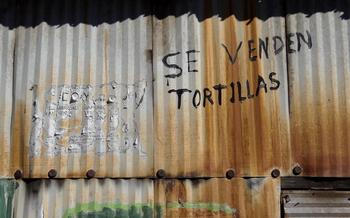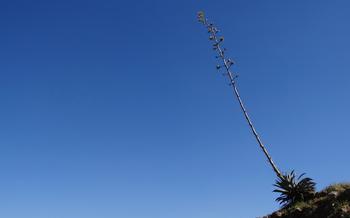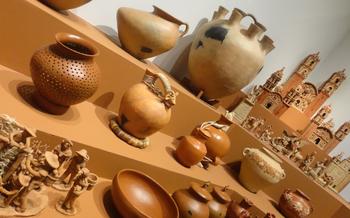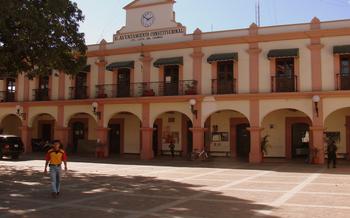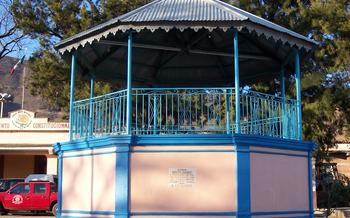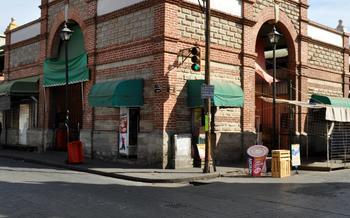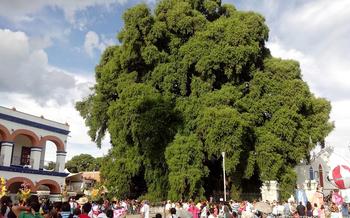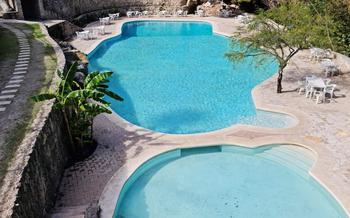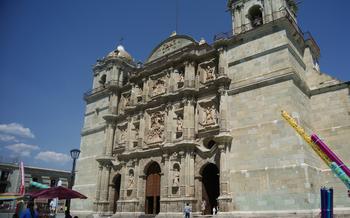
Santa Inés Yatzeche
- Museo Comunitario de Santa Inés Yatzeche: A Window into Zapotec Culture
- Exploring the Archaeological Zone of Lambityeco: Ancient Zapotec Ruins
- Ceremonial Cave of San Juan: A Sacred Zapotec Site
- Witnessing the Guelaguetza Festival: A Celebration of Zapotec Culture
- Learning Zapotec Weaving Techniques: A Living Tradition
- Visiting the Zapotec Market: A Bustling Hub of Local Delights
- Exploring the Natural Beauty of the Yatzeche River
- Indulging in Traditional Zapotec Cuisine: A Culinary Journey
- Meeting the Local Artisans: A Showcase of Zapotec Craftsmanship
- Participating in Zapotec Rituals and Ceremonies: A Unique Experience
- Staying in a Traditional Zapotec Home: A Cultural Immersion
- Supporting Local Conservation Efforts: Protecting Zapotec Heritage
- Ethical and Sustainable Tourism Practices: A Responsible Approach
- Insider Tip: Uncovering Hidden Gems
Museo Comunitario de Santa Inés Yatzeche: A Window into Zapotec Culture
Nestled in the heart of Santa Inés Yatzeche preserving and showcasing its rich heritage.
As you step through the museum's doors, you are greeted by a treasure-trove of artifacts, textiles, and historical documents that narrate the captivating story of the Zapotec people. Interactive exhibits bring to life the ancient traditions, beliefs, and way of life that have shaped this community for centuries.
The museum's collection is a testament to the enduring spirit of the Zapotec culture. From intricately woven textiles adorned with traditional motifs to ancient pottery adorned with symbolic designs, each artifact tells a tale of resilience, creativity, and the enduring connection between the Zapotec people and their land.
Guided tours led by knowledgeable local guides provide an immersive experience, allowing visitors to delve deeper into the significance of the exhibits and gain a profound understanding of Zapotec culture. Educational programs conducted by the museum further enrich the experience, offering workshops, lectures, and demonstrations that promote cultural exchange and foster a sense of appreciation for the Zapotec heritage.
Exploring the Archaeological Zone of Lambityeco: Ancient Zapotec Ruins
The Lambityeco Archaeological Zone is a testament to the rich history and cultural heritage of the Zapotec people. Located just a short distance from Santa Inés Yatzeche, this ancient site offers a glimpse into the lives of the Zapotec people who once inhabited this region.
The most striking feature of the archaeological zone is the main pyramid, a towering structure that dominates the landscape. This pyramid, known as Yagul, was likely used for religious ceremonies and rituals. Other notable structures include ball courts, temples, and residential complexes, providing insights into the daily life and social organization of the Zapotec people.
When visiting the archaeological zone, be sure to take your time to explore the various structures and appreciate the intricate carvings and decorations that adorn them. The site also offers panoramic views of the surrounding countryside, making it an ideal spot to relax and soak in the tranquility of the area.
Tips for exploring the archaeological zone:
- Wear comfortable shoes as the terrain can be uneven and rocky.
- Bring water and sun protection, as there is little shade at the site.
- Consider hiring a guide to learn more about the history of the site and the Zapotec culture.
- Be respectful of the site and its significance to the local community.
Ceremonial Cave of San Juan: A Sacred Zapotec Site
In the heart of Santa Inés Yatzeche lies the Ceremonial Cave of San Juan, a sacred site that holds immense significance in Zapotec culture. This hidden gem is believed to have been a place of worship and ritual for the ancient Zapotec people, serving as a spiritual sanctuary for centuries.
Legends and stories abound regarding the cave's sacred nature. One tale speaks of a young Zapotec man named Juan who sought refuge in the cave during a time of persecution. He prayed to the gods for protection, and in response, a miraculous spring emerged from the cave's depths, providing him with sustenance and shelter. From that day forward, the cave became known as the Ceremonial Cave of San Juan, revered as a place of divine intervention.
To this day, the cave remains a sacred site for the Zapotec people, who visit to pay homage to their ancestors and seek spiritual guidance. Visitors are welcome to explore the cave, but it is essential to be respectful and mindful of its sacred nature. The cave is accessible on foot, and local guides can provide insight into its history and significance.
Whether you are drawn to the cave's spiritual allure or simply fascinated by its historical importance, a visit to the Ceremonial Cave of San Juan is a unique and enriching experience that offers a glimpse into the heart of Zapotec culture.
Witnessing the Guelaguetza Festival: A Celebration of Zapotec Culture
The Guelaguetza Festival is one of the most iconic and vibrant celebrations in Oaxaca, offering a kaleidoscope of Zapotec culture, traditions, and artistry. This annual event, held in July, attracts thousands of visitors from around the world who come to witness the spectacle of traditional dances, music, and performances that showcase the rich heritage of the Zapotec people.
During the festival, the streets of Oaxaca City come alive with a flurry of activity as locals and tourists alike don their colorful traditional attire, creating a vibrant tapestry of colors and patterns. The festival's centerpiece is the grand procession, where delegations from different regions of Oaxaca parade through the streets, showcasing their unique dances and costumes. The air is filled with the rhythmic beats of drums, the melodies of wind instruments, and the joyous laughter of participants and spectators.
Beyond the procession, the Guelaguetza Festival offers a multitude of other attractions, including traditional food stalls serving up an array of Oaxacan delicacies, artisan markets where visitors can purchase handmade crafts and souvenirs, and cultural exhibitions that delve into the history and traditions of the Zapotec people.
To fully experience the Guelaguetza Festival, it's advisable to plan your trip well in advance, as accommodations and transportation tend to fill up quickly. Be sure to arrive early to secure a good spot along the parade route and take your time exploring the various cultural offerings. Remember to respect local customs and traditions, and engage with the locals in a friendly and respectful manner to make the most of this unforgettable cultural extravaganza.
Learning Zapotec Weaving Techniques: A Living Tradition
Weaving holds a profound significance in Zapotec culture and daily life. Traditionally, women have been the primary weavers, perpetuating skills and designs passed down through generations. Their intricate creations adorn traditional clothing, textiles, and household items, showcasing the artistry and creativity of the Zapotec people.
The Santa Inés Yatzeche community is renowned for its exceptional weaving skills. Visitors to the village can immerse themselves in this ancient art form by participating in weaving workshops and learning directly from local artisans. These workshops offer a unique opportunity to gain hands-on experience, understand the symbolism behind the patterns, and create your own woven masterpieces.
Local weavers generously share their knowledge, guiding visitors through the entire process, from selecting the finest yarns to mastering intricate weaving techniques. Whether you are a beginner or an experienced weaver, these workshops cater to all skill levels, allowing you to connect with the living tradition of Zapotec weaving and create a lasting memento of your time in Santa Inés Yatzeche.
Visiting the Zapotec Market: A Bustling Hub of Local Delights
Immerse yourself in the vibrant atmosphere of the Zapotec market, a bustling hub of local delights in Santa Inés Yatzeche. Located in the heart of the village, this market is a testament to the rich cultural heritage of the Zapotec people. Vendors from surrounding communities gather here to showcase their handcrafted goods, fresh produce, and traditional delicacies.
As you wander through the market, you'll be greeted by a symphony of colors, sounds, and aromas. From intricately embroidered textiles to hand-carved wooden figurines, the market offers a diverse array of handicrafts that showcase the exceptional skills of local artisans. You'll also find stalls selling fresh fruits, vegetables, herbs, and spices, all harvested from the fertile lands of the surrounding countryside.
Don't miss the chance to sample some of the delicious local specialties, such as tlayudas, crispy tortillas topped with beans, cheese, and a variety of meats, and memelas, thick tortillas filled with black beans and topped with a spicy tomato sauce. Indulge in the sweet treats as well, such as rosquillas, traditional sugar-coated cookies, and empanadas, pastries filled with fruit or cheese.
Remember to embrace the local custom of bargaining when making purchases. It's a friendly and respectful way to engage with the vendors and get a fair price for your goods. Don't be afraid to strike up a conversation and learn more about the products and the people who make them.
The Zapotec market is more than just a place to shop; it's a vibrant social gathering where locals come to interact, exchange stories, and share their cultural traditions. Take your time exploring the market, soak up the atmosphere, and let the spirit of Santa Inés Yatzeche captivate you.
Exploring the Natural Beauty of the Yatzeche River
The Yatzeche River, a lifeline for the Zapotec people, winds its way through the captivating landscapes of Santa Inés Yatzeche. Its crystal-clear waters, teeming with diverse aquatic life, invite visitors to immerse themselves in the region's natural splendor.
Scenic Landscapes and Hiking Trails:
The riverbanks are adorned with lush vegetation, creating a picturesque panorama that will leave you spellbound. Embark on a leisurely hike along the designated trails, allowing the tranquility of nature to wash away your worries. Capture the breathtaking vistas as you meander through the verdant landscapes, where every bend unveils a new visual masterpiece.
Swimming, Fishing, and Birdwatching:
The Yatzeche River offers a refreshing respite from the sun's embrace. Dive into its cool waters and let the gentle current carry away your cares. Anglers can cast their lines and try their luck at catching a variety of fish species that inhabit the river. For bird enthusiasts, the riverbanks provide an ideal vantage point to observe a diverse array of avian species, their melodious chirping filling the air.
Local Guides and Tour Options:
To enhance your exploration of the Yatzeche River, consider enlisting the services of a local guide. These knowledgeable individuals will lead you to hidden gems along the river, sharing insightful stories and anecdotes about the region's history and culture. Various tour options are available, catering to different interests and preferences. Whether you prefer a leisurely boat ride, an invigorating kayak adventure, or a thrilling fishing expedition, there's something for everyone to enjoy.
Indulging in Traditional Zapotec Cuisine: A Culinary Journey
Zapotec cuisine is a reflection of the region's rich history and culture, showcasing a unique blend of indigenous ingredients and flavors. Must-try dishes include tlayudas, large, crispy tortillas topped with beans, cheese, meat, and vegetables, a staple of Oaxacan cuisine. Another delicacy is mole negro, a complex sauce made with over 20 ingredients, including chocolate, chilies, and spices, usually served with chicken or turkey. Tamales, steamed corn dough filled with various fillings, are another popular dish, often prepared for special occasions.
Local specialties to savor include chapulines, toasted grasshoppers seasoned with chili and lime, a traditional snack. Try tasajo, salted and dried beef, often served as a main course or as a filling for quesadillas. For a refreshing drink, try tejate, a pre-Hispanic beverage made with corn, cacao, and flowers. Mezcal, an agave-based spirit, is another local specialty, enjoyed neat or in cocktails.
To fully immerse yourself in the culinary delights of Santa Inés Yatzeche, visit the local market, where you can find fresh produce, traditional dishes, and handmade snacks. Interact with the friendly vendors, sample local delicacies, and learn about the history and significance of Zapotec cuisine.
Meeting the Local Artisans: A Showcase of Zapotec Craftsmanship
Santa Inés Yatzeche is renowned for its thriving community of artisans who keep the traditions of Zapotec craftsmanship alive. Their skilled hands create beautiful and intricate pieces that reflect the village's rich cultural heritage. Visitors can witness these artisans at work in their workshops, where they transform simple materials into stunning artworks.
Wood carving is a specialty in Santa Inés Yatzeche, and visitors can observe artisans meticulously crafting intricate figures and sculptures from local woods. Each piece is unique, showcasing the artist's skill and creativity. Pottery is another important craft, with artisans using traditional techniques to create functional and decorative pieces. The vibrant colors and intricate designs of Zapotec pottery are a testament to the artisans' mastery.
Textile weaving is a central part of Zapotec culture, and visitors can learn about the traditional techniques used by local weavers. They can watch as skilled artisans transform colorful threads into beautiful woven fabrics, often adorned with intricate patterns and designs. These textiles are used to create traditional clothing, bags, and other items, each one a unique expression of Zapotec artistry.
Meeting the local artisans is a wonderful way to learn about Zapotec culture and support the preservation of traditional crafts. Visitors can purchase handmade souvenirs directly from the artisans, helping to sustain their livelihoods and ensure that these skills continue to be passed down to future generations.
Participating in Zapotec Rituals and Ceremonies: A Unique Experience
The Zapotec people of Santa Inés Yatzeche hold their rituals and ceremonies in high regard, perpetuating their cultural identity and spiritual beliefs. These ceremonies, deeply rooted in Zapotec tradition, offer a unique opportunity for visitors to witness and participate in a living cultural heritage.
One of the most significant ceremonies is the "Fiesta de la Virgen de la Inmaculada Concepción", held annually on December 8th. This festival honors the patron saint of the village and involves colorful processions, traditional dances, and music. Visitors can join the festivities, marvel at the vibrant costumes, and immerse themselves in the joyous atmosphere.
Another essential ceremony is the "Ceremonia del Maíz" or Corn Ceremony, held during the harvest season. This ceremony pays homage to the sacred maize, a staple crop and symbol of life for the Zapotec people. Visitors can witness the rituals, learn about the significance of maize in Zapotec culture, and participate in the communal feast that follows.
Attending Zapotec ceremonies requires sensitivity and respect for local customs and traditions. Visitors should dress appropriately, refrain from taking photographs without permission, and seek guidance from locals to ensure their participation is respectful and meaningful. These ceremonies offer a profound glimpse into the heart of Zapotec culture, showcasing their deep connection to their ancestors, the land, and their spiritual beliefs.
Staying in a Traditional Zapotec Home: A Cultural Immersion
For a truly immersive experience, consider staying in a traditional Zapotec home during your visit to Santa Inés Yatzeche. Homestays offer a unique opportunity to connect with the local community and gain insights into their way of life. Many families in the village open their homes to visitors, providing a warm and welcoming environment.
Staying with a Zapotec family allows you to experience their daily routine, learn about their customs and traditions, and share meals and conversations. You'll have the chance to witness traditional cooking methods, learn about local agriculture, and participate in daily activities such as weaving or farming.
Homestays also provide a great opportunity for language exchange. Many Zapotec families are eager to share their language and culture with visitors, and you'll have the chance to practice your Spanish or learn a few words of Zapotec.
To find a homestay in Santa Inés Yatzeche, you can contact the local tourism office or work with a tour operator that specializes in cultural immersion experiences. Be sure to inquire about the specific arrangements and expectations before booking your stay.
Remember that staying in a Zapotec home is a privilege, and it's important to be respectful of your hosts and their customs. Follow their lead, ask questions, and be open to learning about their way of life. This experience will not only provide you with a deeper understanding of Zapotec culture but also create lasting memories and friendships.
Supporting Local Conservation Efforts: Protecting Zapotec Heritage
The rich cultural and natural heritage of Santa Inés Yatzeche is under increasing pressure from modern development and tourism. In response, several local initiatives and organizations are working tirelessly to protect and preserve this unique region. As a visitor, you can play a vital role in supporting their efforts and ensuring that the Zapotec heritage continues to thrive for generations to come.
One way to support conservation is by visiting and supporting local businesses that are committed to sustainable practices. These businesses often use local materials, employ local workers, and reinvest their profits back into the community. By choosing to stay in eco-friendly hotels, eat at locally-owned restaurants, and shop at fair-trade stores, you can directly contribute to the preservation of Zapotec culture and the environment.
Another way to support conservation is by donating to local organizations that are working to protect the region. These organizations often rely on donations to fund their conservation projects, which may include reforestation efforts, archaeological research, and educational programs. By making a donation, you can help to ensure that the Zapotec heritage is preserved for future generations.
Finally, you can support conservation by simply being a responsible and respectful visitor. This means respecting local customs and traditions, minimizing your environmental impact, and engaging with the community in a positive and respectful manner. By doing so, you can help to create a sustainable tourism industry that benefits both the local people and the environment.
Insider Tip:
To learn more about local conservation efforts, visit the Santa Inés Yatzeche Community Center. The center provides information on local conservation projects and offers opportunities for visitors to get involved.
Ethical and Sustainable Tourism Practices: A Responsible Approach
As a traveler, it is crucial to be mindful of your impact on the local environment and culture. Here are some tips for practicing ethical and sustainable tourism in Santa Inés Yatzeche:
Respect Local Customs and Traditions: Familiarize yourself with local customs and traditions before your visit. Dress appropriately, avoid taking photos of people without their permission, and be respectful of religious ceremonies and rituals.
Minimize Environmental Impact: Reduce your carbon footprint by opting for eco-friendly transportation options like walking, biking, or using public transportation. Conserve water and energy, and dispose of waste responsibly.
Support Sustainable Businesses: Choose to stay in locally-owned guesthouses or homestays, eat at restaurants that source ingredients from local farmers, and buy souvenirs from local artisans. This helps support the local economy and preserves traditional livelihoods.
Engage with the Community: Make an effort to interact with locals in a friendly and respectful manner. Learn a few words of Zapotec, ask questions about their culture, and listen to their stories. This helps foster cultural exchange and understanding.
Protect Natural Resources: Avoid littering, damaging plants or animals, and disturbing wildlife. Respect the natural beauty of the region and leave no trace when exploring the natural attractions.
By following these tips, you can contribute to the preservation of Santa Inés Yatzeche's cultural and natural heritage while ensuring that your travel experiences are both enriching and sustainable.
Insider Tip: Uncovering Hidden Gems
Beyond the popular attractions, Santa Inés Yatzeche holds a treasure trove of hidden gems waiting to be discovered by curious travelers. Venture off the beaten path to uncover these secret spots, where you'll find authentic cultural experiences and breathtaking natural beauty.
One such hidden gem is the Cerro de la Santa Cruz, a sacred hilltop with panoramic views of the surrounding valley. Hike to the summit to witness stunning sunsets and immerse yourself in the spiritual atmosphere of this sacred site.
For nature enthusiasts, the Rio Yatzeche offers secluded swimming holes, cascading waterfalls, and lush vegetation. Explore the river's hidden corners by following local trails, or hire a guide to lead you to the most picturesque spots.
If you're seeking unique cultural experiences, visit the local artisans' workshops, where you can observe skilled craftsmen creating beautiful textiles, pottery, and wood carvings. Engage with the artisans, learn about their techniques, and purchase one-of-a-kind souvenirs directly from the source.
To truly immerse yourself in Zapotec culture, consider staying in a traditional Zapotec home. Homestay options allow you to live alongside a local family, sharing meals, participating in daily activities, and gaining a deeper understanding of their way of life.
Remember to approach these hidden gems with respect and humility, asking permission before entering sacred spaces and interacting with the locals in a friendly and respectful manner. Your genuine curiosity and open-mindedness will be rewarded with unforgettable experiences and a deeper connection to the heart and soul of Santa Inés Yatzeche.
